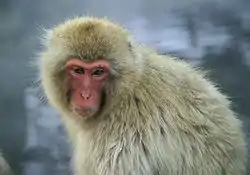猿
| ||||||||
Translingual
| Stroke order | |||
 | |||
Han character
猿 (Kangxi radical 94, 犬+10, 13 strokes, cangjie input 大竹土口女 (KHGRV), four-corner 44232, composition ⿰犭袁)
References
- Kangxi Dictionary: page 716, character 19
- Dai Kanwa Jiten: character 20584
- Dae Jaweon: page 1128, character 9
- Hanyu Da Zidian (first edition): volume 2, page 1361, character 15
- Unihan data for U+733F
Chinese
| simp. and trad. |
猿 | |
|---|---|---|
| 2nd round simp. | 𤝌 | |
| alternative forms | ||
Glyph origin
Phono-semantic compound (形聲/形声, OC *ɢʷan) : semantic 犭 + phonetic 袁 (OC *ɢʷan).
Etymology
From Proto-Sino-Tibetan *b/g-woj-n (“monkey”).
Alternatively, the root may be Austroasiatic; compare Proto-Mon-Khmer *swaaʔ (“monkey”) (Schuessler, 2007); compare also Proto-Mon-Khmer *kwaɲ ~ kwaaɲʔ.
Pronunciation
Compounds
- 人猿
- 人猿泰山
- 人猿科
- 元謀猿人/元谋猿人
- 吼猿
- 巨猿
- 心猿意馬/心猿意马 (xīnyuányìmǎ)
- 意馬心猿/意马心猿
- 拉瑪猿/拉玛猿
- 檻猿籠鳥/槛猿笼鸟
- 狐媚猿攀
- 猿人 (yuánrén)
- 猿狖
- 猿猴 (yuánhóu)
- 猿猴取月
- 猿科
- 猿穴壞山/猿穴坏山
- 猿腸寸斷/猿肠寸断
- 猿臂
- 猿鶴沙蟲/猿鹤沙虫
- 猿鶴蟲沙/猿鹤虫沙
- 白猿
- 白猿傳/白猿传
- 窮猿失木/穷猿失木
- 窮猿奔林/穷猿奔林
- 窮猿投林/穷猿投林
- 籠鳥檻猿/笼鸟槛猿
- 縱放心猿/纵放心猿
- 藍田猿人/蓝田猿人
- 虎體猿臂/虎体猿臂 (hǔ tǐ yuán bì)
- 虛引猿泣/虚引猿泣
- 蟲沙猿鶴/虫沙猿鹤
- 調弓號猿/调弓号猿
- 豹頭猿臂/豹头猿臂 (bàotóuyuánbì)
- 長臂猿/长臂猿 (chángbìyuán)
- 類人猿/类人猿 (lèirényuán)
See also
- 猴 (hóu)
Japanese
Readings
Etymology 1

| Kanji in this term |
|---|
| 猿 |
| さる Grade: S |
| kun’yomi |
From Old Japanese. Appears in the Man'yōshū, completed some time after 759 CE.
Ultimate derivation possibly borrowed from Ainu サロ (saro, “monkey”, from サㇻ (sar, “a tail”) + オ (o, “to bear, to wear, to carry”)).[1]
The kanji is from Chinese 猿 (yuán, “ape”). Compare Japanese 猪 (inoshishi, “boar”) from Chinese 猪 (zhū, “pig”) and Japanese 豚 (buta, “pig”) from Chinese 豚 (tún, “suckling pig”).
Noun
- a monkey (primate)
- 1079, Konkōmyō Saishōōkyō Ongi, page 10 (back):
- 猕猴 二字合訓佐流
- (please add an English translation of this quotation)
- Short for 日本猿 (Nihonzaru, “Japanese macaque”).
- (loosely) an ape (animal)
- 1988 July 30 [1984 July 25], Fujiko F. Fujio, “世界名作童話第3巻 うらしま太郎 (世界名作童話第3巻 うらしま太郎) [World’s Renowned Fairy Tales Book 3: Urashima Tarō]”, in ポストの中の明日 [Post-Mid-Tomorrow] (藤子不二雄少年SF短編集; 2), 10th edition, volume 2 (fiction), Tokyo: Shogakukan, →ISBN, page 117:
- 地球は、サルのわく星になっていましたとさ。
- Chikyū wa, saru no wakusei ni natte imashita to sa.
- Meanwhile, Earth became the Planet of the Apes.
- 地球は、サルのわく星になっていましたとさ。
Usage notes
As with many terms that name organisms, this term is often spelled in katakana, especially in biological contexts (where katakana is customary), as サル.
Derived terms
- 日本猿 (Nihonzaru)
- 狐猿 (kitsunezaru)
- 猿も木から落ちる (saru mo ki kara ochiru)
- 申 (saru)
Descendants
- → Yami: sazo
Etymology 2
| Kanji in this term |
|---|
| 猿 |
| まし Grade: S |
| kun’yomi |
From Old Japanese. Appears in the Man'yōshū, completed some time after 759 CE, used phonetically to spell the sound /masi/.
Ultimate derivation unknown.
Usage notes
This form seems to be used less often than mashira below.
Etymology 3
| Kanji in this term |
|---|
| 猿 |
| ましら Grade: S |
| kun’yomi |
Derived from earlier mashi form above. Found in texts from the early 1900s, possibly earlier. Appears to be mashi + the pluralizing and genericizing suffix ら (ra).
Pronunciation
Etymology 4
| Kanji in this term |
|---|
| 猿 |
| えん Grade: S |
| kan’on |
From Middle Chinese 猿 (MC hjwon).
The kan'on pronunciation, so likely a later borrowing.
Pronunciation
- IPA(key): [ẽ̞ɴ]
Derived terms
- 猿臂 (enpi): a monkey's elbow; someone skilled at archery
- 類人猿 (ruijin'en): an anthropoid
References
- John Batchelor (1905) An Ainu-English-Japanese dictionary (including a grammar of the Ainu language), Tokyo, London: Methodist Publishing House; Kegan Paul, Trench, Trubner Co.
- Matsumura, Akira, editor (2006), 大辞林 [Daijirin] (in Japanese), Third edition, Tōkyō: Sanseidō, →ISBN
- Kindaichi, Kyōsuke et al., editors (1997), 新明解国語辞典 [Shin Meikai Kokugo Jiten] (in Japanese), Fifth edition, Tōkyō: Sanseidō, →ISBN
- Tsukishima, Hiroshi (1079) Kojisho Ongi Shūsei 12: Konkōmyō Saishōōkyō Ongi (in Japanese), Tōkyō: Kyūko Shoin, published 1979, →ISBN.
Korean
Etymology
From Middle Chinese 猿 (MC hjwon). Recorded as Middle Korean 𫞤/원 (wen) (Yale: wen) in Hunmong Jahoe (訓蒙字會 / 훈몽자회), 1527.
Compounds
- 견원 (犬猿, gyeonwon)
- 원인 (猿人, wonin, “apeman; prehistoric man”)
- 유인원 (類人猿, yuinwon, “anthropoid”)
Vietnamese
Han character
猿: Hán Nôm readings: viên, vượn, ươi
- This term needs a translation to English. Please help out and add a translation, then remove the text
{{rfdef}}.
Readings
- Nôm: viên, vượn
References
- Thiều Chửu : Hán Việt Tự Điển Hà Nội 1942
- Trần Văn Chánh: Từ Điển Hán Việt NXB Trẻ, Ho Chi Minh Ville, 1999
- Vũ Văn Kính: Đại Tự Điển Chữ Nôm, NXB Văn Nghệ, Ho Chi Minh Ville